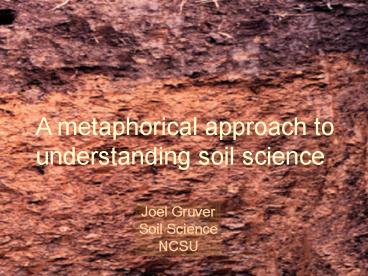Joel Gruver - PowerPoint PPT Presentation
1 / 62
Title: Joel Gruver
1
A metaphorical approach to understanding soil
science
Joel Gruver Soil Science NCSU
2
What is a soil pedon ?
a soil individual
3
INPUTS
OUTPUTS
Parent material Climate Topography Organisms T
ime
SOIL FORMATION
TRANS- LOCATIONS
TRANS- FORMATIONS
Adapted from Stewart (1990)
4
Soils in the southeast are diverse !
5
Young Soils
Old Soils
Very acid Thin top soil Low phosphorus
http//www.mo15.nrcs.usda.gov/features/gallery/
6
(No Transcript)
7
Sand
(0.05 2 mm)
Silt
(0.002 0.005 mm)
Primary mineral particles
Clay
(lt 0.002 mm)
http//ianrpubs.unl.edu/fieldcrops/graphics/soilh2
o2.gif
8
12 textural classes
Textural triangle
http//www.oneplan.org/Images/soilMst/SoilTriangle
.gif
9
Loamy soils
10
Texture strongly influences soil hydraulic
properties
11
(No Transcript)
12
Clay and humus are the soil skin
http//www.ccma.csic.es/dpts/suelos/
Brady and Weil (2002)
clay minerals
humus
13
- What is humus ????
- While it is unlikely that any 2 humus molecules
are identical the diverse products of
humification have many common characteristics - Extreme chemical complexity
- Resistance to further decomposition
- High specific surface and negative charge
- Dark color
14
Why is the soil skin important ?
- Adsorption of water films
- Adsorption of organic and inorganic chemicals
- Ion exchange
- Catalysis of chemical reactions
- Habitat for bacteria
15
Crumb structure
Compacted soil
The soil fabric
http//www.grdc.com.au/growers/gc/gc48/conference1
.htm
16
Granular crumb structure
17
20 yrs of bluegrass, then 5 yrs CT corn
25 yrs of CT corn
18
After adding water
25 yrs of conventional corn
20 yrs of bluegrass, then 5 yrs conventional corn
19
Plasticity vs. Friability
Friable soils crumble easily when subjected to
mechanical stress. Tillage requires less draft !
20
Angular blocky structure enhances drainage and
root growth below the plow layer
Ray Weil
21
Biofilms cover lt 5 of soil surfaces
Soil is habitat
22
Soil presents its inhabitants with many
constraints
Tortuous, loosely connected and highly
constricted porosity
Low quality nutritional resources
Structural rigidity
Environmental fluctuations
23
Average microbial growth rates are hundreds of
times slower in field soil than in a petri dish
24
The metabolic potential of soil microbial
communities greatly exceeds available organic
substrates
25
Why do microorganisms behave so differently in
soil than they do in a petri dish ?
http//picturethis.pnl.gov/im2/8208417-5cn0/820841
7-5cn.jpg
26
La Paradoja de la Bella Durmiente
The Sleeping Beauty Paradox
27
(No Transcript)
28
(No Transcript)
29
Who are the prince charmings ?
30
Soil organisms are concentrated
in HOT SPOTS !
Porosphere
Drilosphere
Aggregatusphere
Detritusphere
Rhizosphere
31
Most of the bacteria in soil are unculturable
volume gt 0.1 ?m3, gt 40 culturable volume lt 0.1
?m3, lt 1 culturable
t2
t3
t1
Starvation time
(Morita, 1989)
32
Aestivating earthworm in East Texas forest soil
SSAJ 69(3) cover
33
Most plants are in a state of dormancy
34
Soil fauna have a disproportionate impact on soil
nutrient and energy fluxes
35
Soil fauna are relatively mobile
but have limited digestive ability
Soil microflora are relatively immobile but have
almost unlimited digestive ability
36
Microfoodwebs
I want some bacteria for lunch !
Microfauna (e.g. protozoa and nematodes) harness
the microfloras digestive abilities by grazing
on them.
37
Exhabitational digestion
When microarthropods feed on fresh litter, their
fecal pellets contain shredded, moistened and
mixed but largely undigested residues.
Reingestion of fecal pellets after a few days of
microbial activity greatly increases
assimilation.
38
Rumen digestion enables earthworms and termites
to utilize complex substrates
Ecosystem Engineers
39
The Soil Stomach
- Bacteria
- Fungi
- Algae
- Protozoa
- Nematodes
- Microarthropods
- Enchytraeids
- Earthworms
- Ants, termites, spiders
- Mollusks
- Others rodents, snakes,
- voles, amphibians, etc.
Body size increasing
Microflora
Microfauna
Mesofauna
Macrofauna
Megafauna
40
The fence post principle
Schriefer (2000)
41
The soil pore network serves as a respiratory
and circulatory system
http//www.mtm.kuleuven.ac.be/Research/NDT/IDO_SHe
rman_final.ppt
42
Tillage affects the pore network
white zones are pores
No-till soil
Tilled soil
(Young and Ritz, 2000)
43
Intensive tillage
Long term no-till
Ontario Ministry of Ag and Food
44
Pore diameter
Drainage pores
10-30 µm
Field Capacity
Most available
Plant available water
Permanent wilting point
0.2 µm
Hygroscopic water
Adapted from Buol (2000)
45
Least Limiting Water Range
? LLWR for loose well-aggregated soil ?
?LLWR for compacted soil?
Root growth rate
20 25 30 35 40 45 50 55
dry Soil water content, cm3/cm3 100 wet
From Weil, 2003
Ray Weil
46
Crusts impede seedling emergence, infiltration of
water and gas exchange
http//www.oznet.ksu.edu/soybeanscene/may24.htm
47
high residue
high infiltration
48
(No Transcript)
49
Ontario Ministry of Ag and Food
50
Whats in the soil soup ??
Ca2
DOM
NO3-
Ca2
Mg2
NO3-
H2PO4-
Ca2
DOM
K
NO3-
K
Mg2
Ca2
DOM
NO3-
Mg2
DOM
Ca2
SO4-2
Adapted from Brady and Weil (2002)
51
Which forms of nutrients are available to plants ?
solution
exchangeable
active OM
passive OM
weatherable minerals
52
Re-seasoning the soup
Highly buffered
Poorly buffered
Modified from Havlin et al. (1999)
53
Understanding nutrient uptake
H20
Root exudates activate soil microbes
Transpirational stream
H20
Root extension
54
?
Feed the soil vs. Feed the crop ?
Both are important
Healthy roots need available nutrients !
Unhealthy roots use nutrients inefficiently
Acute root disease
Chronic root malfunction
55
The acid infertility complex
56
Whats wrong with soil acidity ?
Aluminum becomes insoluble at pH 5.5
Aluminum is soluble at low pHs
Aluminum is toxic to plant roots
57
http//www.ppi-ppic.org/
Avoid overliming !!
58
- Routine soil testing
- Goals
- Rapid
- Cheap
- Predictive
- Widely applicable
59
Meaningful interpretation of soil test results
requires field calibration
100 yield
50 yield
http//www.ipm.iastate.edu/ipm/icm/2003/11-17-2003
/mehlich3.gif
60
Crop yield
Deficiency Symptoms
Nutrient availability
61
Why doesnt the NCDA lab test for N ???
Preseason soil mineral N is a poor predictor of
seasonal availability of N
Total soil N is also a poor predictor of seasonal
availability of N
62
?































